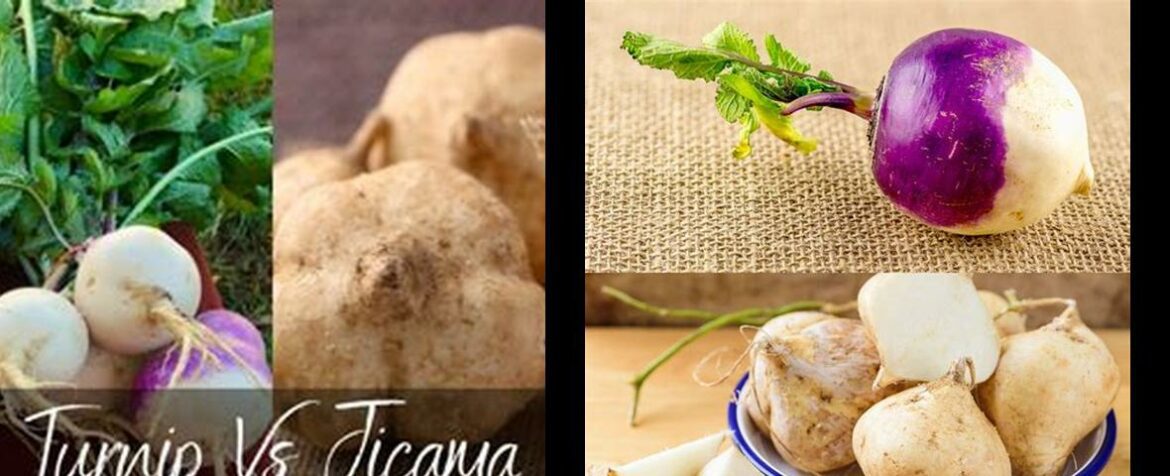Jicama vs turnip: Looking for a delicious and nutritious addition to your meals? Look no further than the battle of the root vegetables: Jicama vs Turnip! These two powerhouse veggies are packed with vitamins, minerals, and fiber, making them a must-have in any healthy diet. But which one should you choose? In this comparative guide, we’ll dive deep into the world of Jicama and Turnip, uncovering their unique flavors, nutritional profiles, and versatile uses. Get ready to discover the root of all culinary wonders!
Jicama vs Turnip: A Comparative Guide to Two Nutritious Root Vegetables
In the realm of root vegetables, jicama and turnip stand out as culinary gems, each boasting distinctive flavors, textures, and nutritional profiles. This comprehensive guide delves into the intricacies of these two vegetables, highlighting their differences and culinary applications.
Visual Distinction: Unveiling the Contrasting Appearances
At first glance, jicama and turnip present a striking contrast in appearance. Turnips, with their rotund shape and smooth, creamy-white skin, exude an air of familiarity. Jicamas, on the other hand, are elongated and adorned with a rough, brownish bark-like skin, hinting at their exotic origins.
Textural Symphony: Exploring the Nuances of Firmness and Crispness
Biting into a turnip reveals a firm texture, its flesh ranging from white to yellowish. This firmness lends itself well to various cooking methods, from boiling and roasting to sautéing and stir-frying. Jicama, in contrast, offers a crisp, juicy texture reminiscent of an apple. Its refreshing crunch makes it a delightful addition to salads and snacks, although it can also be incorporated into soups and stir-fries for a textural twist.
Taste Profile: Navigating the Spectrum of Sweetness and Pungency
Turnips possess a slightly bitter or pungent flavor with a hint of spiciness, a characteristic that adds complexity to savory dishes. Jicamas, on the other hand, are renowned for their sweet and juicy flavor, with a mildness that makes them a versatile ingredient. This sweetness shines through when eaten raw, whether in salads or as a refreshing snack.
Nutritional Landscape: Unveiling the Health Benefits of Turnip and Jicama
Both turnips and jicama hold their own in the nutritional arena. Turnips are low in calories and brimming with vitamin C, fiber, and potassium, making them a wholesome addition to a balanced diet. Jicamas, while slightly lower in calories, are rich in dietary fiber, vitamin C, potassium, and iron, further bolstering their nutritional value.
Culinary Canvas: Unveiling the Versatile Nature of Turnip and Jicama
Turnips and jicama transcend culinary boundaries, effortlessly adapting to a myriad of cooking techniques and dishes. Turnips excel in soups, stews, and stir-fries, where their firm texture and earthy flavor add depth and substance. They can also be grated or spiralized into low-carb pastas and noodles, offering a healthier alternative to traditional wheat-based options. Jicama, with its crisp texture and mild sweetness, is often enjoyed raw in salads or as a snack. It can also be added to soups and stir-fries for a refreshing crunch. Its versatility extends to Asian cuisine, where it serves as a popular substitute for water chestnuts, adding a delightful texture to dishes.
Health Benefits: Exploring the Healing Properties of Turnip and Jicama
Turnips and jicama not only tantalize the taste buds but also harbor an array of health benefits. Turnips, with their abundance of vitamin K, support bone health and play a role in blood clotting. Turnip greens, often overlooked but equally nutritious, are rich in vitamins A and C, as well as iron, making them a formidable nutritional powerhouse. Jicamas, with their high fiber content, promote digestive health and satiety, contributing to weight management efforts.
Selecting and Storing: Ensuring Optimal Quality and Freshness
When selecting turnips and jicamas, choose firm, unblemished specimens that feel heavy for their size. Avoid those with signs of bruising or decay. Store turnips and jicamas in a cool, dry place for optimal freshness. For extended storage, they can be refrigerated for up to two weeks.
Culinary Inspiration: Unleashing the Potential of Turnip and Jicama
The culinary possibilities with turnips and jicama are endless. Experiment with different recipes to explore their versatility. Roast turnips with herbs and olive oil for a simple yet flavorful side dish. Sauté them with garlic and ginger for an Asian-inspired stir-fry. Transform jicama into a refreshing slaw with a tangy dressing. Create a unique salsa by combining jicama, tomatoes, and cilantro. The options are limitless, inviting you on a culinary journey of exploration and delight.
In conclusion, jicama and turnip, with their distinct flavors, textures, and nutritional profiles, offer a wealth of culinary possibilities. Whether enjoyed raw or cooked, these root vegetables add depth, texture, and flavor to a variety of dishes. Embrace their versatility and incorporate them into your meals to experience their unique culinary charms.
FAQ about Jicama Vs Turnip
Q: How do jicama and turnip differ in appearance?
A: Jicama has an elongated shape and rough, brownish bark-like skin, while turnips are round with smooth, creamy-white skin.
Q: What are the nutritional benefits of turnips?
A: Turnips are low in calories and high in vitamin C, fiber, and potassium, making them a nutritious addition to a balanced diet.
Q: What nutrients are found in jicama?
A: Jicama is rich in dietary fiber, vitamin C, potassium, and iron, providing various nutritional benefits.
Q: Can jicama and turnip be eaten raw?
A: Yes, both jicama and turnip can be enjoyed raw, adding a unique texture and flavor to dishes.
Q: How can jicama and turnip be incorporated into meals?
A: Jicama and turnip are versatile ingredients that can be used in a variety of dishes, whether raw or cooked, to enhance flavor, texture, and depth.
Q: Are jicama and turnip commonly used in culinary applications?
A: Yes, jicama and turnip are both popular ingredients in various cuisines, offering a range of culinary possibilities.


